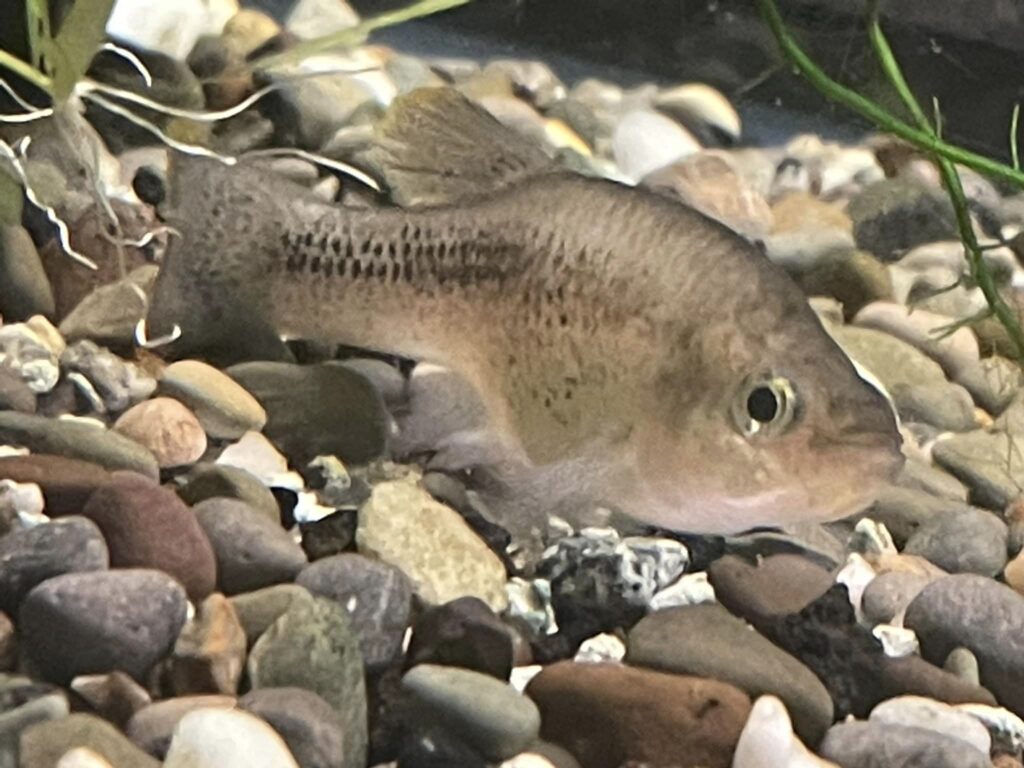Xenotaenia resolanae is a splitfin livebearer endemic to Mexico in the regions of Jalisco and Colima. Their habitats consist of murky streams filled with silt and mud with little vegetation. These fishes can be found at a dept of 3 feet or more with water temperatures between 73-78 degrees Fahrenheit. Because of the continued degradation of their environment, X. resolanae is listed as vulnerable by the International Union for the Conservation of Nature (IUCN).
These fish tend to be stocky and can reach a length of 3 inches. Males can be easily distinguished from females by the Andropodium (sexual organ that is notched at the seventh ray of the anal fin) and a larger dorsal. In some cases, females may be more vibrantly colored.
Unlike many species of splitfins that require a higher volume of vegetation in their diet, X. resolanae is considered a carnivore. I have been feeding my fish a variety of brine and krill flakes, baby brine shrimp, and freeze-dried daphnia and bloodworms. I also provide spirulina flakes a couple times weekly.
I first came across these fish last summer on Aquabid. At first glance upon receiving a pair, I knew they were unlike most of the splitfins I have been breeding in my fish room over the last four years. These fish were more robust and would require a larger aquarium. Therefore, they were acclimated to a 40-gallon aquarium consisting of a few live plants and small rock formations. Water parameters were maintained at 74 degrees Fahrenheit, pH of 7.8 and a DH of 30.
After giving them a week to settle into their new environment, I began conditioning the pair by feeding them a protein rich diet and doing a fifty percent water change weekly. Within weeks, I noticed the male becoming more assertive with the female. At times, he became aggressive to the point where I had to remove her for a day or two because his interest was relentless. After a day or two of resting, I placed her back into the aquarium with the male. Soon after, I noticed the female’s stomach starting to round out. I moved her to a twenty-gallon aquarium that was densely planted where she could give birth without the male impeding. Within 50 days, the female gave birth to ten live fry that were 1⁄4 of an inch long. The fry were active and taking live baby brine at first feeding. Although the mother did not seem to pay that much attention to the fry, I removed the fry to their own aquarium so that they could easily feed without competition from their mother for food.
The fry were fed four times daily with baby brine shrimp and crushed brine and spirulina flake. Fifty percent of the water in the rearing tank was changed twice weekly to maintain water quality due to heavy feeding. The young of this species tend to grow rather fast. And within 12 weeks, they were added to the 40-gallon aquarium with the parents. Presently, all fish are doing well and thriving. I am hoping for another drop of fry before the end of the year.
Reflecting over the last year of working with this species, I find their behavior similar in comparison to dwarf cichlids in temperament. They require amble room to swim and should be monitored for aggression. Providing ample space and crevices can lessen aggressive behavior with tank mates. Although X. resonlanae is an interesting fish to maintain in aquaria, I feel that they are not an appropriate species for the beginning hobbyist. However, to the aquarist willing to invest the time in maintaining this species; the outcome can be rewarding.
Edward R. Moats
Ed’s Aquatic Exotics



